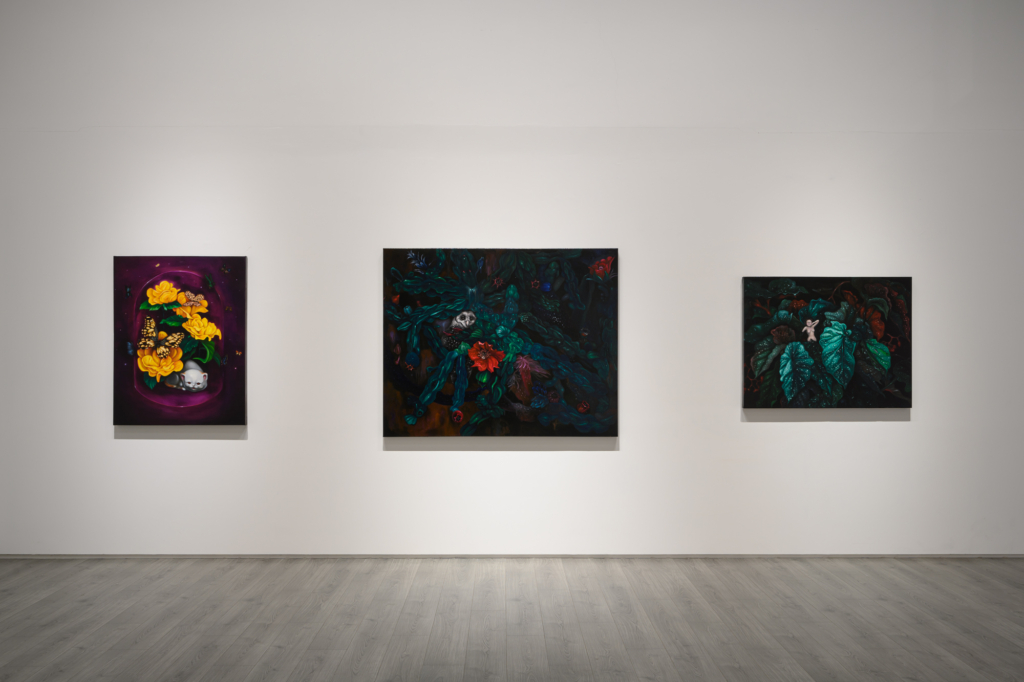Painting: The Nature of Presence
2023.11.25 – 2024.01.20
Artists | LU Hao-Yuan, LU Xiang-Yi, LIANG Yu-Ning, CHUNG Shun-Wen
The exploration of the human-nature relationship is approached differently across disciplines. Some actively propose solutions, while others are concerned with the environment and the physical or mental well-being of humans. In the realm of the arts, the traditional narrative of nature writing and a desire to reconnect with nature makes “restoring the connection” has become a new approach that begins with self-consciousness, mindfulness, and a renewed perspective of how we experience and consider our relationship with ourselves and the world. Throughout the history of paintings, nature has been the subject of artists and a symbol for expressing one’s relationship to the external world. In the case of landscape painting, the artist’s intent is not solely to replicate nature, but rather to represent a subjective response, capturing an uninterrupted interaction with the landscape. Contemporary landscape especially carry greater significance for painters as external surroundings rather than the scene, reflecting the artist’s interactions with it.
Contemporary paintings often rely on depictions of objects or scenes to convey the painter’s awareness of the intimate relationship within the self, the painter-landscape relationship, and the external world. In a time of environmental change, ecopsychologists call on humankind to appeal to their senses, to perceive the reality of their “being on Earth” as a respite. If we try to adopt a way of mindful balance, we can maintain a balanced attention to various relationships in the realms of tranquility and presence, and our emphasis on perception and subjectivity points towards a reciprocal process of deep listening and healing. From this point of view, the exhibition hopes to explore how art, and especially painting, can remind us of our ability to perceive. The painter, through pictorial expressions, reveals to us their insights on plants, landscapes, and life, as well as the ways they open up the self through each brushstroke and painting technique, acknowledging the fact that all life systems are interconnected and interdependent.
I can always perceive an intimacy between the painter and the subject in these works. This intimacy goes beyond a state of endearment, expressing a profound understanding and coexistence. LU Xiang Yi’s depictions of landscapes are all revelations of the conversations between the artist and the land. The crimson earth is where she stands, and it’s the starting point of all the journeys, whether into the mountains or towards the sea. Each step and each pause have been marked by a profound awareness of reality. CHUNG Shun-Wen portrays nameless wildflowers and grasses encountered along the road with delicate and tender strokes. These quiet and non-assertive presences are not truly nameless, but rarely become the focus of attention. CHUNG’s depictions of these plants symbolize mutual understanding and recognition at the intersections of all life.
In contrast, LIANG Yu-Ning’s depictions of plants are extremely physical, conveying the vitality of plants in an almost anthropomorphic way. The fluorescent rays that illuminate the artworks also demonstrate aggression, with metaphors of allure and danger lurking in the supple plant forms.
LU Hao-Yuan’s works take a more oppressive stance in overtly representing a deep and sunken sensibility, with suppressed and death-related imagery beneath the exuberant and vibrant beauty, simultaneously embedded in a cheerful disposition. In his earlier works depicting everyday plants, we find a more relaxed relationship between seeing and coexisting.
Awareness leads to awakenings. Through painting, the artist turns each visual encounter into a stroke on the canvas, successively laying down their relationship with the subject and scenery. What each artwork reveals for us is not only the formal perception of a subject, but also the earnest act of a person wielding a brush in the moment, jotting down the story. Painting is presence, and in paintings, we never fail to capture the resonances between nature, the artist, and ourselves.















